
Salvia mellifera is a small, highly aromatic, evergreen shrub of the genus Salvia native to California, and Baja California, Mexico. It is common in the coastal sage scrub of Southern California and northern Baja California. Black sage has a dark appearance, especially during drought.
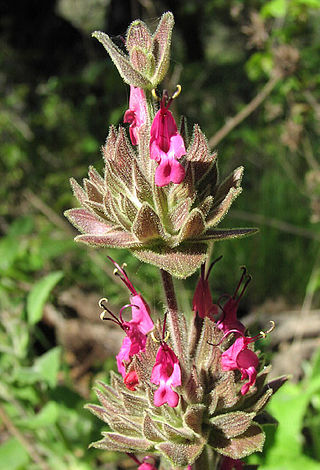
Salvia spathacea, the California hummingbird sage or pitcher sage, is a species of flowering plant in the family Lamiaceae, native to southern and central California growing from sea level to 610 m (2,001 ft). This fruity scented sage blooms in March to May with typically dark rose-lilac colored flowers. It is cultivated in gardens for its attractive flowering spikes and pleasant scent.

Salvia hians is a mound-forming perennial, native to the Himalayas from Pakistan to Bhutan. It is common in Kashmir, growing at elevations from 2,400 to 4,000 m on open slopes and forests. The plant was described in 1830 by John Forbes Royle, a British botanist living in India who studied the medicinal properties of Himalayan plants.

Salvia pratensis, the meadow clary or meadow sage, is a species of flowering plant in the family Lamiaceae, native to Europe, western Asia and northern Africa. The Latin specific epithet pratensis means "of meadows", referring to its preferred habitat. It also grows in scrub edges and woodland borders.

Salvia greggii, the autumn sage, is a herbaceous perennial plant native to a long, narrow area from southwest Texas, through the Chihuahuan Desert and into the Mexican state of San Luis Potosi, typically growing in rocky soils at elevations from 5,000 to 9,000 ft. It was named and described in 1870 by botanist Asa Gray after Josiah Gregg, a merchant, explorer, naturalist, and author from the American Southwest and Northern Mexico, who found and collected the plant in Texas. It is closely related to, and frequently hybridizes with, Salvia microphylla. Despite the common name "autumn sage", it blooms throughout the summer and autumn.
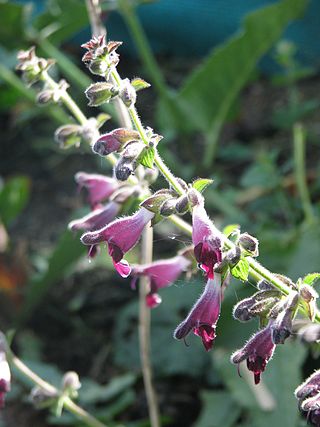
Salvia castanea is a herbaceous perennial plant discovered in the Yunnan Valley in China in 1904 by plant collector George Forrest. It also grows in Nepal, Bhutan, and Tibet. The plants used in horticulture today likely came from seed collected from a plant at 14,000 ft in Nepal, at the base of Mt. Everest. It grows 3 ft tall in the wild, and 1–2 feet in cultivation in Europe and the U.S. The few 1.0–1.5 in flowers grow in whorls on an inflorescence about 1 ft long. The name castanea, which means 'chestnut colored', refers to the purplish-maroon flowers
Salvia flava is a herbaceous perennial shrub native to Yunnan province in China, growing in large numbers at 7,500-13,000 ft elevation. It grows on hillsides and along streambanks in gravelly soil with maples, willows, viburnum, berberis, and clematis.
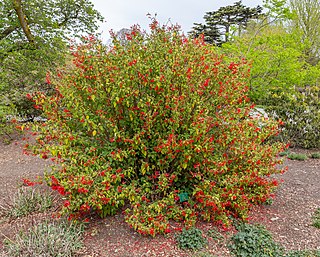
Salvia gesneriflora is a herbaceous perennial plant or subshrub native to mountainous provinces of the Sierra Madre Oriental in Mexico, growing at 7,500–10,000 ft (2,300–3,000 m) elevation. The long tubular flowers of this salvia resemble Gesneria flowers. It is a popular ornamental plant.
Salvia cuspidata is a perennial shrub native to the Andes mountains in Bolivia, Chile, and Peru, growing at elevations up to 10,000 ft (3,000 m).

Salvia indica is a species of herbaceous perennial plant belonging to the family Lamiaceae. It is native to a wide region of Western Asia that includes Israel, Iraq, Iran and Turkey. It was first described by the taxonomist Carl Linnaeus in 1753. It is unknown why he gave it the specific epithet indica, since the plant is not from India. While Salvia indica is classified as a herbaceous perennial, in cultivation individual plants often live no longer than two years.
Salvia merjamie is a herbaceous perennial plant that is native to the east African highlands from Ethiopia to Tanzania, and also across the Red Sea in Yemen. It grows between 6,000 and 13,000 feet elevation in grasslands, forest edges, rocky outcrops, basalt slopes, and fallow fields. The specific epithet merjamie is derived from meryamiye, the Arabian common name for the plant, which is shared with other local Salvia species such as Salvia lanigera. The Maasai common name for S. merjamie is Naingungundeu, meaning that the plant smells of rats, though the variety that is common in horticulture is named 'Mint Sauce' and is described as having a strong minty aroma. S. merjamie shares a similar distribution with Salvia nilotica, though they are not known to hybridize.
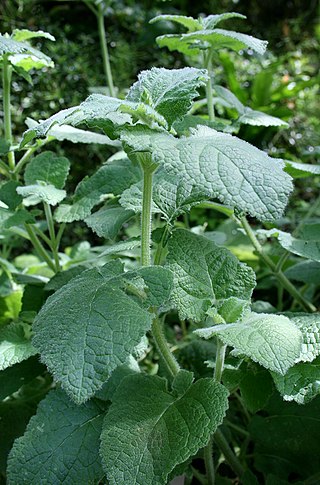
Salvia przewalskii is a herbaceous perennial plant native to the Chinese provinces of Gansu, Hubei, Sichuan, Xizang, and Yunnan, typically growing along stream banks, forest edges, among shrubs, and on granitic hillsides. It was described and named in 1881 by the Russian botanist Carl Maximowicz after the Russian explorer and botanist Nikolai Przhevalsky, who made several collecting trips to China in the 19th century. The plant is widely known throughout its native habitat for its medicinal properties.

Salvia recurva is a woody-based perennial native to the cloud forests of Central America, limited to the northern slopes of Oaxaca, Chiapas, and Guatemala at elevations around 10,000 feet (3,000 m). It grows where there is year-round warmth and abundant moisture in the air and on the forest floor. Salvia recurva was described by George Bentham in 1848, with the specific epithet referring to the distinct curve in the inflorescence when it first appears.
Salvia cyclostegia is a perennial plant that is native to forests, grasslands, and hillsides in Sichuan and Yunnan provinces in China, growing at elevations from 2,700 to 3,300 m. The leaves are broadly ovate to circular, and range in size from 2.3 to 13 cm long and 1.2 to 6.5 cm wide.
Salvia evansiana is a perennial plant that is native to Sichuan and Yunnan provinces in China, found growing on alpine meadows, hillsides, and forests at elevations from 3,400 to 4,300 m. It has erect stems growing 13 to 45 cm tall, with ovate to triangular-ovate leaves that are 2 to 11 cm long and 1 to 11 cm wide.
Salvia pauciflora is a perennial plant that is native to Yunnan province in China, growing in and around forests at 2,800 to 3,400 m elevation. It grows on 2–4 slender unbranched stems with widely spaced leaves. The leaves are broadly ovate to ovate-triangular, typically ranging in size from 2.5 to 6 cm long and 1.2 to 5 cm wide.
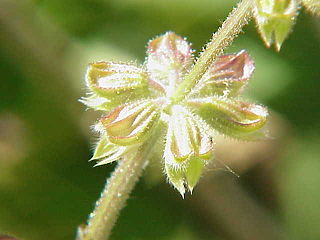
Salvia bulleyana is a perennial plant that is native to Yunnan province in China, growing on hillsides at 2,100 to 3,400 m elevation. S. bulleyana grows on a few branched stems with ovate to ovate-triangular leaves.
Salvia bifidocalyx is a perennial plant that is native to Yunnan province in China, found growing on rocky mountains at 3,500 m (11,500 ft) elevation. S. bifidocalyx has a few slender ascending stems that reach 33 cm (13 in) tall, with hastate leaves that are 2 to 5 cm long and 1.7 to 3 cm wide.

Salvia yunnanensis is a perennial plant that is native to Yunnan, Guizhou, and Sichuan provinces in China, found growing on grassy hillsides, forest margins, and dry forests at 1,800 to 2,900 m elevation. S. yunnanensis has tuberous roots and grows on erect stems to 30 cm (12 in) tall, with simple oblong-elliptic leaves that are 2 to 8 cm long and 1.5 to 3.5 cm wide.
Salvia cavaleriei is an herb that is native to Guangdong, Guangxi, Guizhou, Hubei, Hunan, Jiangxi, Shaanxi, Sichuan, and Yunnan provinces in China, growing in forests, on hillsides, and streamsides at 500 to 2,700 m elevation. S. cavaleriei is a short, robust plant reaching 12 to 32 cm tall. Inflorescences are widely spaced 2–6 flowered verticillasters in terminal racemes or panicles, with a blue-purple to purple-red or white corolla that is approximately 0.8 cm (0.31 in).











